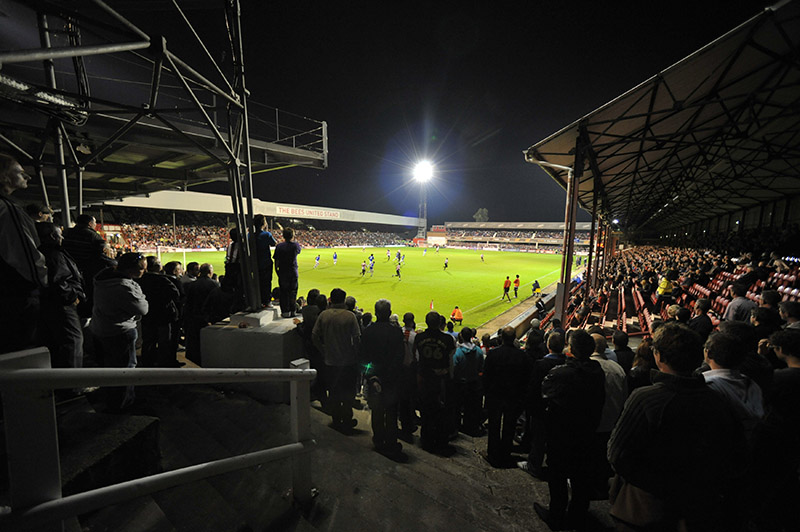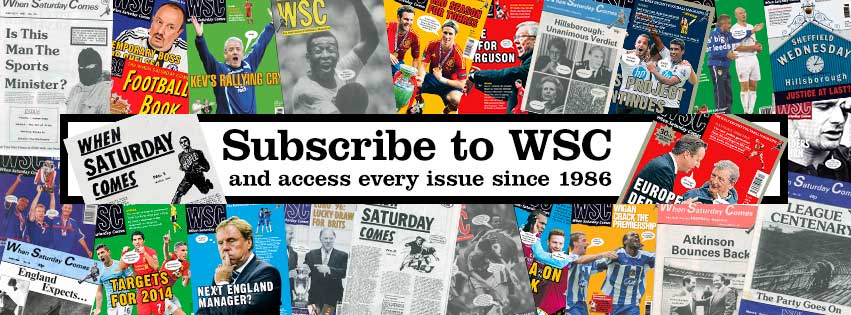
Fans don’t go to Brentford’s stadium for prestige, they go for the local character and, recently, the brilliant entertainment
23 July ~ I recently took my son to his first night game at Griffin Park. Crossing London by Tube we arrived in west London and alighted on to the dark, open-air platform of South Ealing station. After a quick walk we arrived at the noisy junction of the M4 motorway and ventured across the traffic on a shall-we-shan’t-we dash to the other side of the road. Once there a floodlit Griffin Park came in to view sitting neatly behind terraced houses.
I grew up in north Ealing in the 1970s where the most popular club in the area were Queens Park Rangers. I went to Loftus Road a couple of times but could never warm to them. My favourite team back then were Leeds United after I’d watched them win the FA Cup final, the first I can remember, with Allan Clarke’s nonchalant diving header against Arsenal in 1972. My second team were Brentford. They were the opposite of First Division sides like Leeds and QPR. At Griffin Park there were no pretensions and, as an abiding lower-division side who rarely fought for promotion or against relegation, they didn’t get much coverage. A bus ride away but overlooked by many, they were to be discovered by the discerning few unlike the other brasher, headline-hogging London clubs.
Brentford itself was not cosmopolitan. The streets around the ground are situated in a nondescript suburb of small, well-kept houses, tower blocks and corner pubs. In the mid-1970s the home terrace smelt of pipe tobacco and you could wander round it freely or climb up on the floodlights to get a better view. One of the best games I saw there was against Graham Taylor’s Watford in 1979, a brilliant end-to-end contest that finished 3-3, and which, unusually, featured on ITV’s The Big Match.
Following a long absence, and after my interest in Leeds waned, I started going to matches again in the 1990s and found that not much had changed. Local characters, like film extras, were there in the pubs. At the Bricklayers Arms, “Jack” would hold court boasting about his days as a champion rower. With his large nose, short-cropped mackintosh and scruffy brown trilby he bore a resemblance to his near-namesake the French film comedian Jacques Tati. In the corner a white-haired Stan Bowles sat close to the public pay-phone, drinking vodka and orange, patiently waiting to call his bookmaker.
This was the period when football became modernised and mass-produced, with games hyped-up and televised every night, although there wasn’t much evidence of that at Brentford and the friends I went to games with witnessed some mediocre displays. One, an Arsenal season ticket holder, estimates he watched a dozen or more games over the years without ever seeing Brentford score. Against Glenn Hoddle’s Swindon Town in 1993 two opponents were sent off early in the first half but Brentford failed to take advantage. The plan seemed to be to win as many corners as possible before over-hitting or mistiming each and every one of them. There was also the occasional belter – such as the match against Bristol Rovers in January 1994 when cult player Denny Mundee, renowned for his “shuffle” move (a quick pair of stepovers), scored a great hat-trick but we cruelly lost the match 4-3 in the final moments.
Today we are no longer a middling, lower-league club. Under first Uwe Rösler, then Mark Warburton and now Dean Smith we are contenders in the Championship, a league considered to be one of the most competitive in the world. We play thoughtful football with speed and control and can more than hold our own. My son is spreading the word and has persuaded some of his school friends to make the long journey across town to see a game. The simplicity and enjoyment of going to see the Bees has captured his imagination.
At the recent night game there was still room for eccentricity. During a break in play I heard a soft, ringing sound behind me. Turning round, a man in a large overcoat had produced a triangle from his inside pocket and was striking it enthusiastically. I nudged my son to look and we both smiled at each other. It turned out to be a busy evening for our percussionist as Brentford scored five goals that night and, as the cheers for each goal subsided, we heard the bucolic tinkling sound over and over again. Dermot Kavanagh
Photo by Simon Gill/WSC Photos: Brentford’s Griffin Park under floodlights
This article first appeared in WSC 376, June 2018. Subscribers get free access to the complete WSC digital archive – you can find out more here
